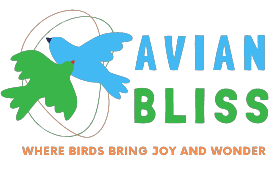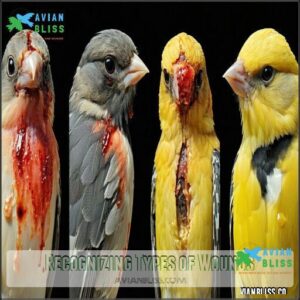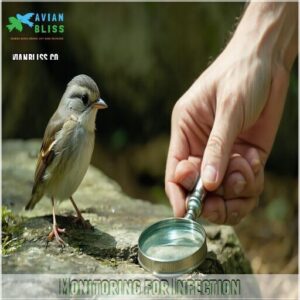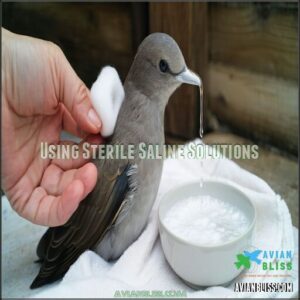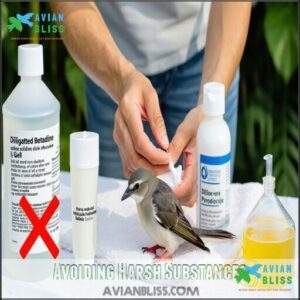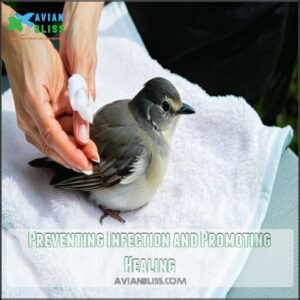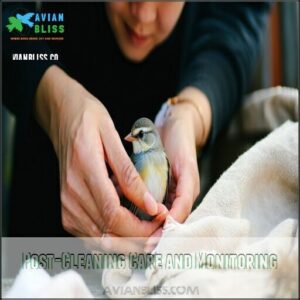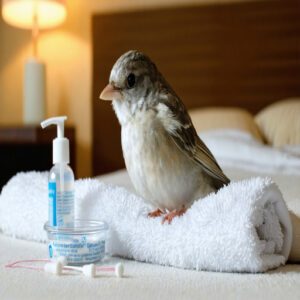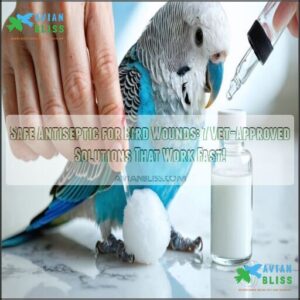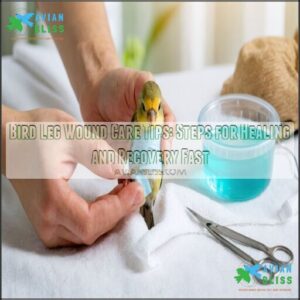This site is supported by our readers. We may earn a commission, at no cost to you, if you purchase through links.
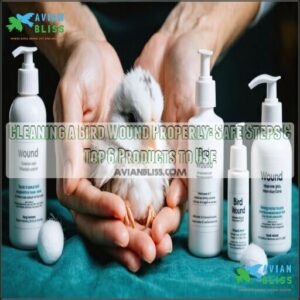
First, wash your hands thoroughly. Gently rinse the wound with lukewarm saline solution (½ teaspoon salt in 1 cup water) using a clean cotton ball.
Avoid hydrogen peroxide or alcohol as these can damage tissue. Pat dry with sterile gauze and apply a thin layer of bird-safe antibiotic ointment.
Keep the area clean and monitor for redness, swelling, or discharge. Like mending a torn kite, proper wound care requires patience.
Veterinarians recommend specific products that can make the difference between swift healing and complications.
Table Of Contents
- Key Takeaways
- Assessing Bird Wounds
- Cleaning Bird Wounds
- Top 6 Bird Wound Cleaning Products
- Preventing Infection and Promoting Healing
- Post-Cleaning Care and Monitoring
- Frequently Asked Questions (FAQs)
- What should I do if my bird has a wound?
- What can I put on a bird wound?
- Can hydrogen peroxide be used on bird wounds?
- What should I do if my bird has a bacterial infection?
- What to do if a bird is injured?
- What to do if a bird has a broken bone?
- What to clean a bird wound with?
- How long can a bird’s wound heal on its own?
- Can you put neosporin on a bird wound?
- Is hydrogen peroxide safe for bird wounds?
- Conclusion
Key Takeaways
- Clean the wound gently with a sterile saline solution or diluted Betadine, avoiding harsh substances like alcohol or hydrogen peroxide.
- Apply a thin layer of bird-safe antibiotic ointment without painkillers to prevent infection and promote healing.
- Monitor the wound daily for signs of infection like redness, swelling, or discharge, and seek veterinary care for serious injuries or worsening symptoms.
- Create a quiet environment for your bird, removing hazards and providing proper perches to aid recovery.
Assessing Bird Wounds
When evaluating a bird’s wound, start by observing for signs of bleeding, swelling, or unusual behavior.
Carefully check the area to identify the type and severity of the injury, ensuring you don’t cause the bird additional stress.
Identifying Signs of Injury
Spotting bird injury symptoms early is key.
Look for these signs:
- Behavioral changes like lethargy or unusual aggression.
- Feather condition—ruffled or missing feathers can indicate trauma.
- Breathing issues such as wheezing or open-mouthed breathing.
Don’t forget to check for appetite loss or poor limb function, as these might signal underlying problems needing prompt bird wound care.
Recognizing Types of Wounds
When evaluating bird wounds, focus on wound type.
Puncture wounds need quick care due to deep infection risks.
Burn severity varies, so check for blistering.
Fracture identification can prevent movement-related pain.
Bruise assessment detects hidden trauma, while bumblefoot signs like foot sores require specialized bird wound cleaning.
Careful wound evaluation is essential for effective bird injury diagnosis and timely treatment.
Changes in behavior, such as increased sleeping duration, can also indicate underlying health issues.
Monitoring for Infection
Redness, swelling, or discharge are common bird wound infection signs you shouldn’t ignore.
Keep an eye on changes in behavior, like unusual quietness or reduced appetite, as they might signal trouble.
Monitor healing progress daily, and if symptoms worsen, act quickly.
Stick to antiseptic solutions for cleaning, ensuring infection prevention while keeping your bird comfortable and stress-free.
Cleaning Bird Wounds
Cleaning your bird’s wound properly is essential to prevent infection and promote healing.
I’ll create a short, engaging blockquote about bird wound cleaning that maintains the same informative yet caring tone:
Proper wound cleaning isn’t just about care—it’s your bird’s best chance for swift, infection-free healing.
Using a sterile saline solution and a bird-safe antibiotic ointment guarantees the wound stays clean without causing irritation.
Using Sterile Saline Solutions
In the context of bird wound cleaning, a sterile saline solution is a gentle yet effective antiseptic.
It hydrates wounds and prevents infection without stinging.
Follow these steps:
- Use single-use saline packets for purity and convenience.
- Gently apply it with a cotton ball or sterile gauze.
- Always store larger saline containers in a clean, dry place.
Remember to use recommended antiseptic solutions like povidone iodine for effective cleaning, and consider the importance of a clean environment.
Applying Antibiotic Ointments
After cleaning with sterile saline, apply a bird-safe antibiotic ointment to prevent infections.
Use a tiny amount to avoid feather matting and follow vet advice. Avoid products with painkillers or steroids.
Many owners find it useful to buy specialized ointments for their avian companions.
| Safe Options | Avoid |
|---|---|
| Neosporin (Original) | Thick, oily ointments |
| Raw honey (natural use) | Vaseline |
| Silver sulfadiazine | Pain-relief additives |
| Aloe vera gel | Salves with steroids |
Avoiding Harsh Substances
When cleaning bird wounds, skip harsh substances like undiluted hydrogen peroxide or alcohol. These can irritate bird skin sensitivity.
Instead, opt for safe alternatives like antiseptic solutions, diluted Betadine, or sterile saline. Natural remedies like aloe vera gel also work well.
Proper dilution is key for bird wound cleaning—research products and their toxicity awareness to guarantee safety.
Cat bites, for example, often require aggressive cleaning techniques due to the risk of infection.
Top 6 Bird Wound Cleaning Products
Choosing the right products for your bird’s wound care makes a big difference in healing. These top recommendations are safe, effective, and easy to use at home.
1. Neosporin Original Antibiotic Ointment Infection Protection
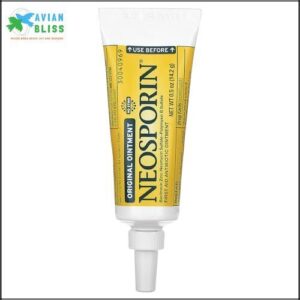
Neosporin Original Antibiotic Ointment is a reliable go-to for treating minor bird wounds.
Its blend of neomycin sulfate, bacitracin zinc, and polymyxin B guarantees 24-hour infection protection. A tiny dab, applied sparingly, can prevent infections and promote healing without causing harm to birds.
Avoid overuse and make certain it doesn’t contain painkillers, which can be toxic. This ointment is lightweight, absorbs quickly, and won’t leave greasy residue.
Keep it handy in your first-aid kit—it’s a lifesaver for those unexpected injuries, providing infection protection.
Best For: Families, individuals, and pet owners looking for effective and gentle infection protection for minor cuts, burns, and scrapes.
- Provides 24-hour infection protection and minimizes scarring.
- Absorbs quickly without leaving a greasy residue.
- Suitable for sensitive skin and children, making it versatile.
- Small tube size may not last long with frequent use.
- Childproof cap can be slightly difficult to open.
- Not suitable if the formula contains added painkillers.
2. NeilMed Sterile Saline Wound Wash
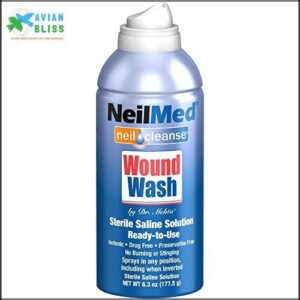
NeilMed Sterile Saline Wound Wash is a top choice for cleaning bird wounds safely and effectively.
Thanks to its preservative-free, isotonic saline formula, it cleans without stinging or burning—ideal for your bird’s delicate skin.
The spray works in any direction, though some users say it’s a bit tricky to control initially.
Avoid spraying directly; instead, apply it with a sterile gauze to prevent overspray.
It’s a convenient, no-fuss option to cleanse minor injuries and keep infections at bay while ensuring your bird’s comfort.
Best For: Those looking for a gentle, effective solution to clean minor wounds, piercings, or abrasions with minimal discomfort.
- Preservative-free, isotonic saline formula that cleans without stinging or burning.
- Convenient, multi-directional spray for easy application.
- Safe for sensitive skin and minor wounds, preventing infections.
- Spray nozzle can be difficult to control, causing overspray and waste.
- Strong stream unsuitable for direct use on certain injuries or piercings.
- Higher price compared to similar wound care products.
3. Vetericyn Plus Dog Wound Care Spray
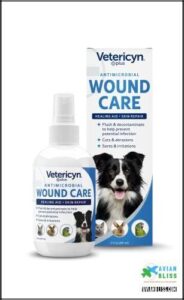
Vetericyn Plus Dog Wound Care Spray is a game-changer for bird injuries.
This non-toxic, pH-balanced spray helps clean wounds without stinging, making it stress-free for your feathered friend.
Its advanced hypochlorous technology prevents infections while keeping wounds moisturized for faster healing.
Safe for delicate areas like around the eyes or beak, it’s incredibly versatile and easy to use—just spray directly, no rinsing required.
Veterinarian-recommended, it’s ideal for cuts, abrasions, or skin irritations, and you should keep one handy in your pet first aid kit to ensure you’re always prepared with a stress-free solution.
Best For: Pet owners, wildlife rescuers, and veterinarians looking for a safe, effective, and non-toxic wound care solution for animals of all species.
- Non-toxic and safe for use around sensitive areas like eyes and mouth.
- Easy-to-use spray format with adjustable nozzle provides hassle-free application.
- Promotes fast healing by cleaning and moisturizing wounds.
- Requires frequent application throughout the day for optimal results.
- Unscented formula, which may not appeal to users who prefer scented products.
- The sprayer head may need replacement if it malfunctions.
4. PetSilver Chicken Wound Care Spray
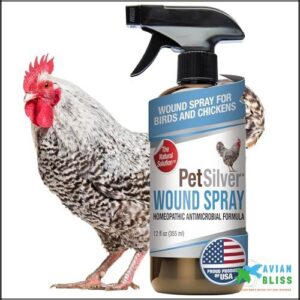
If you’ve got a bird with wounds to care for, PetSilver Chicken Wound Care Spray might be your new best friend.
This all-natural spray uses chelated silver and distilled water to soothe and heal without stinging.
Its spray stream reaches up to 6 feet, so you can treat nervous birds with ease.
Plus, it’s safe if they peck at it.
Whether it’s bumblefoot, cuts, or burns, this gentle and effective spray gets the job done without making your feathered friend uncomfortable.
Best For: Bird and chicken owners looking for a natural, safe, and easy-to-use solution for wounds, cuts, or skin irritations.
- All-natural formula with chelated silver and distilled water.
- Allows application from up to 6 feet away, ideal for nervous birds.
- Safe for birds to peck or lick during and after use.
- Relatively high price at $28.47 for a 12 fl oz bottle.
- Limited to external use only.
- May require frequent applications for optimal results.
5. Zymox Avian Topical Spray for Birds
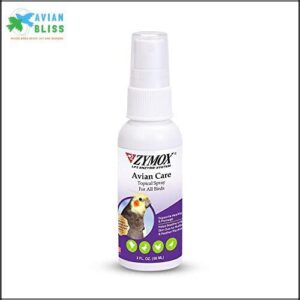
If you’re looking for a reliable wound care option, Zymox Avian Topical Spray is a game-changer for birds’ skin health.
Its LP3 Enzyme System, combined with aloe vera and zinc gluconate, soothes irritated skin, promotes healing, and prevents infections.
This spray is non-toxic, steroid-free, and gentle enough for everyday use, even on sensitive skin.
Whether it’s abrasions, wounds, or bumblefoot, Zymox guarantees thorough care while strengthening feathers.
Just spray directly on affected areas for quick relief and healthier plumage.
Best For: Birds of all species, especially those with wounds, irritated skin, or feather plucking issues.
- Soothes and promotes healing of wounds and abrasions.
- Strengthens feathers and improves overall bird health.
- Non-toxic, gentle, and safe for daily use.
- Some users report product leakage during shipping.
- One incident of adverse reaction resulted in a cockatiel’s death.
- Requires careful application to avoid misuse or overdosing.
6. Pefei Precision Eyebrow Tweezers Set
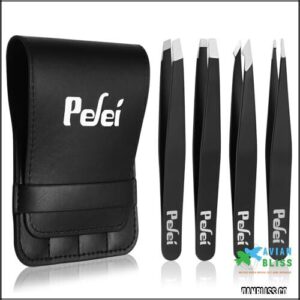
The Pefei Precision Eyebrow Tweezers Set isn’t just for grooming—it’s a lifesaver for bird wound care.
With four stainless steel tweezers, you’ll handle splinters or debris safely and precisely. The pointed styles are excellent for removing tricky fragments without causing more harm, while the sleek leather case keeps everything organized.
Plus, their durable design means they’re ready for repeated use. Whether you’re tackling a tough spot or maintaining a clean wound, these tweezers bring precision and ease to bird first-aid.
Minor cuts can be addressed, but remember to seek veterinary care for deep wounds, and consider the tweezers as part of your bird first-aid kit, providing ease to the process.
Best For: People looking for a versatile, durable, and precise set of tweezers for grooming, splinter removal, or bird wound care.
- Some users report the grip could be stronger.
- Mixed opinions on performance versus packaging appeal.
- Larger size may feel less comfortable for small hands.
- Four unique tweezers with precision tips for versatile use.
- Durable #420 stainless steel construction for long-term reliability.
- Comes with a stylish leather travel case for convenience.
Preventing Infection and Promoting Healing
You can help your bird heal faster by keeping their wound clean, dry, and protected from dirt and bacteria.
Regularly changing bandages and using bird-safe remedies like warm compresses can make a big difference in preventing infection.
Keeping Wounds Clean and Dry
When cleaning a bird wound, keeping it dry is just as important as disinfecting it. Dampness invites trouble, increasing infection risks.
Here’s a compelling blockquote that captures the key message about keeping bird wounds dry while maintaining the same informative tone:
Moisture is infection’s best friend – keep bird wounds clean and thoroughly dry for successful healing.
- Use bird-safe enclosures with minimal humidity.
- Gently pat the wound after applying an avian antiseptic.
- Monitor for moisture during regular checks.
- Avoid sealing Bandage Application too tightly to let air circulate and support Wound Drying.
Beak injuries may require specialized emotional support to reduce stress, which is a critical aspect of the healing process.
Changing Bandages Regularly
Keeping wounds dry matters, but regular bandage changing truly supports healing.
Follow frequency guidelines: daily changes for wound dressing birds or every 2-4 days, depending on soiling.
Use soft bandage material for a secure application without stress. Consider using specialized avian bandages for ideal comfort and support.
During bird wound care, monitor for signs of discomfort. Gentle handling reduces stress and keeps bird wound bandaging effective.
Applying Warm Compresses
While fresh bandages protect wounds, warm compresses can work wonders for your bird’s healing process.
Apply a gentle compress to promote blood circulation and reduce inflammation around the wound site.
You can find a suitable bird wound compress online.
- Use a clean cloth dampened with warm (not hot) water
- Maintain compress temperature between 100-105°F
- Limit application duration to 5-10 minutes twice daily
- Monitor your bird’s response and discontinue if distressed
Post-Cleaning Care and Monitoring
After cleaning your bird’s wound, you’ll need to keep a watchful eye on the healing process to guarantee proper recovery.
You should monitor for any signs of infection like redness or swelling, while providing a clean, stress-free environment that allows your feathered friend to rest and heal comfortably.
Observing for Signs of Infection
Vigilant eyes can save your bird’s life when monitoring for infection.
Watch for redness, swelling, heat, or unusual discharge around the wound—these are classic infection signs.
Any foul odor after bird wound cleaning is concerning.
Check twice daily, especially in the first 48 hours.
If you notice increasing discomfort or pus despite using antiseptic solutions, don’t wait—contact your vet immediately.
Bird wound antiseptic use can’t replace professional care.
Providing a Safe Environment
After spotting signs of infection, you’ll need to create a birdsafe environment for your feathered friend to heal properly.
Recovery requires a stress-free space where your bird can rest undisturbed.
- Remove cage hazards like loose threads, sharp toys, or toxic plants that could cause additional injuries
- Use safe perches with appropriate textures to prevent foot strain during healing
- Maintain a quiet atmosphere with minimal handling to reduce bird stress and promote faster healing
Seeking Veterinary Care When Necessary
While creating a safe recovery space is important, sometimes professional help is non-negotiable.
Take your bird to an avian veterinarian immediately for serious injuries like fractures, deep puncture wounds, or wounds near joints.
Don’t wait if you notice worsening symptoms such as increased discharge, swelling, or lethargy after home treatment.
Bird wound veterinary consultation helps prevent post-treatment complications and guarantees proper healing through professional diagnosis.
Frequently Asked Questions (FAQs)
What should I do if my bird has a wound?
Clean the wound with diluted Betadine or saline solution using a cotton ball.
Apply bird-safe antibiotic ointment, bandage gently, and monitor for infection.
Seek veterinary care for deep cuts or if symptoms worsen.
What can I put on a bird wound?
Treat a bird’s wound gently—like handling a fragile feather.
Use diluted Betadine or sterile saline to clean it, then apply a bird-safe antibiotic ointment sparingly.
Avoid ointments with painkillers, and always monitor for infection signs to ensure the wound heals properly and does not lead to further infection.
Can hydrogen peroxide be used on bird wounds?
You can use hydrogen peroxide on bird wounds, but only when diluted with water to avoid harming delicate tissue.
Stick to a 1:10 ratio, and rinse with sterile saline afterward to guarantee gentle, effective cleansing.
What should I do if my bird has a bacterial infection?
If your bird has a bacterial infection, visit an avian vet promptly.
Follow their advice, whether it’s antibiotics or care tips.
Don’t DIY meds—birds are sensitive!
Monitor for improvements, and guarantee a clean, stress-free environment.
What to do if a bird is injured?
Stay calm and handle the bird gently.
Check for visible injuries, control bleeding with a clean cloth or styptic powder, and keep it warm.
Contact an avian vet immediately for serious wounds or infection signs.
What to do if a bird has a broken bone?
If a bird breaks a bone, handle it gently to avoid more harm.
Secure it in a small, soft-lined carrier, and contact an avian vet immediately.
Avoid splinting yourself—improper fixes can worsen injuries!
What to clean a bird wound with?
Reach for sterile saline or diluted Betadine (1:10 with water) to clean wounds.
Stay away from alcohol or tea tree oil—they’re harmful.
Gently dab with a cotton ball, keeping things clean and stress-free for the bird.
How long can a bird’s wound heal on its own?
A bird’s minor wound generally heals within a few days to a week, as long as it stays clean and infection-free.
Monitor for redness, swelling, or discharge—any sign of trouble needs a vet’s attention.
Can you put neosporin on a bird wound?
You can use Neosporin on a bird’s wound, but stick to the regular kind without added painkillers.
Apply a thin layer sparingly, as birds groom themselves, and ingesting too much could be harmful.
Is hydrogen peroxide safe for bird wounds?
Hydrogen peroxide isn’t ideal for bird wounds since it can irritate delicate tissue.
Instead, stick to diluted Betadine or sterile saline for cleaning.
Birds deserve gentle care, so skip harsh solutions when tending to injuries.
Conclusion
Caring for a bird’s wound is like repairing fine lace—it takes patience and the right tools.
By cleaning a bird wound properly with gentle saline rinses, bird-safe ointments, and expert-recommended products, you’re setting the stage for a smooth recovery.
Keep the area clean, watch closely for infection, and don’t hesitate to consult a vet if needed.
Your careful attention can make all the difference in helping your feathered friend heal swiftly and comfortably.
